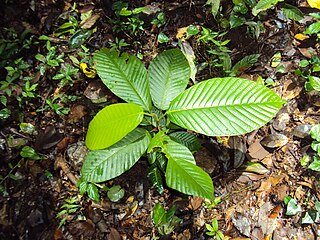
Dipterocarpus is a genus of flowering plants and the type genus of family Dipterocarpaceae.
Adrorhizon purpurascens is a species of orchid. It is the only species in the genus Adrorhizon and one of three genera in the subtribe Adrorhizinae.

Cyanotis is a genus of mainly perennial plants in the family Commelinaceae, first described in 1825. It is native to Africa, southern Asia, and northern Australia.
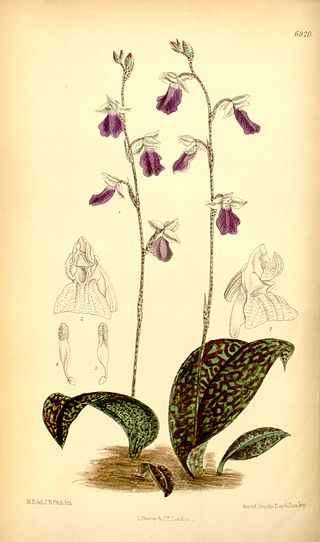
Hemipilia is a genus of plants in the family Orchidaceae. It is native to China, the Himalayas and Southeast Asia.

Panisea is a genus of plant in family Orchidaceae. It is native to China, the Indian Subcontinent, and Indochina.

Rhynchostylis is a genus in the orchid family (Orchidaceae), closely allied to the genus Vanda and comprising four currently accepted species native to the Indian Subcontinent, China, Indochina, Malaysia, Indonesia and the Philippines.

Robiquetia, commonly known as pouched orchids, is a genus of flowering plants from the orchid family, Orchidaceae. Plants in this genus are epiphytes with long, sometimes branched, fibrous stems, leathery leaves in two ranks and large numbers of small, densely crowded flowers on a pendulous flowering stem. There are about eighty species found from tropical and subtropical Asia to the Western Pacific.

Trichoglottis, commonly known as cherub orchids or 毛舌兰属 , is a genus of flowering plants in the family Orchidaceae. Orchids in this genus are epiphytic plants with thick roots, relatively thick, fibrous stems and many large, thick, leathery leaves arranged in two ranks. The flowers are usually small and yellowish with light brown or purple markings. The flowers have broad sepals, narrower petals and a labellum which has three lobes and is often hairy. There are about 85 species distributed from tropical and subtropical Asia to the north-western Pacific. Most species grow in rainforest.

Chrysoglossum is a genus of flowering plants from the orchid family, Orchidaceae. Its 4 species are native to China, the Indian Subcontinent, southeast Asia, New Guinea and some islands of the western Pacific.
- Chrysoglossum assamicumHook.f.. - Guangxi, Tibet, Assam, Thailand, Vietnam
- Chrysoglossum ensigerumW.Burgh & de Vogel - Sumatra
- Chrysoglossum ornatumBlume - India, Nepal, Assam, Bhutan, Sri Lanka, Cambodia, Thailand, Vietnam, Malaysia, Java, Borneo, Sulawesi, Sumatra, Philippines, New Guinea, Fiji, New Caledonia, Samoa, Vanuatu, China
- Chrysoglossum reticulatumCarr - Sabah, Sarawak
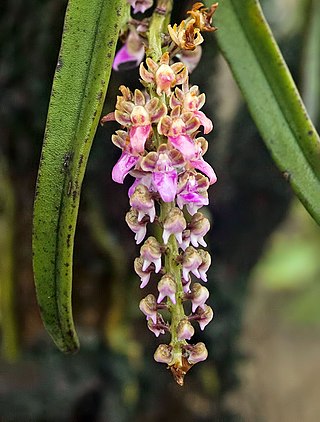
Diplocentrum is a genus of flowering plants from the orchid family, Orchidaceae. It has two known species:

Diploprora is a genus of flowering plants from the orchid family, Orchidaceae. It contains two recognized species, native to Asia:
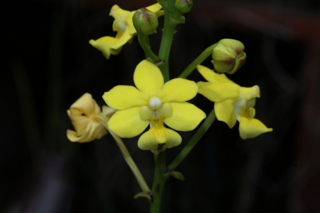
Taprobanea is a genus of flowering plants from the orchid family, Orchidaceae. There is only one known species, Taprobanea spathulata, native to India and to Sri Lanka.

Papilionanthe is a genus of flowering plants from the orchid family, Orchidaceae. It is native to Southeast Asia, southern China, and the Indian Subcontinent.

Peristylus, sometimes commonly known as ogre orchids or bog orchids is a genus of flowering plants from the orchid family, Orchidaceae. It consists of over 100 known species found across much of eastern and southern Asia as well as in Australia and on many islands of the Indian and Pacific Oceans.

Pomatocalpa, commonly known as bladder orchids, or 鹿角兰属 , is a genus of about twenty five species from the orchid family, Orchidaceae. Plants in this genus are epiphytes or lithophytes with thick, leathery leaves and a large number of small flowers with a three-lobed labellum. There are about twenty five species found from tropical and subtropical Asia to the south-west Pacific.

Pteroceras is a genus of flowering plants from the orchid family, Orchidaceae. It is native to China, the Indian Subcontinent, and Southeast Asia.
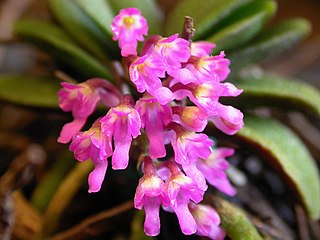
Schoenorchis, commonly known as flea orchids, or 匙唇兰属 in Chinese, is a genus of flowering plants from the orchid family, Orchidaceae. Plants in this genus are small epiphytes with thin roots, thin leafy stems with leaves in two ranks and tiny fragrant, almost tube-shaped flowers with a prominently spurred labellum. There are about twenty five species found from tropical and subtropical Asia to the Western Pacific.

Ipsea speciosa, the daffodil orchid, is a rare wild orchid found in the hills of Sri Lanka and southern India. It is a terrestrial herb with pseudobulbous stem. The lanceolate leaves of the plant are grass like and pointed at the end. Its large flowers appear from September to February, they are bright yellow and sweet-scented.

Anisochilus is a genus in the family Lamiaceae, commonly called as Kapuri first described in 1830. It is native to China, the Indian Subcontinent, and Indochina. Has healing properties that deal with treatment for ailments known as gastric ulcer and helps with dermis issues. Anisochilus also has active properties such as camphor, leutiolin, and apigenin. A new hygrine-like compound has been found within the DNA of this plant.
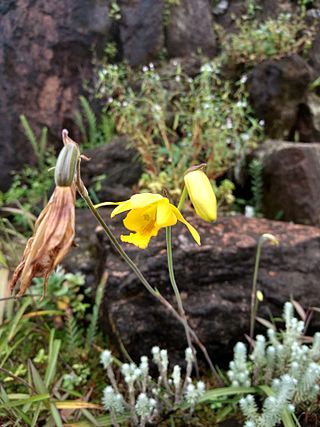
Ipsea malabarica, the Malabar daffodil orchid, is a species of ground orchids endemic to the high altitude hills of the southern Western Ghats in India. It was not seen in the wild for many years after its description and was rediscovered by K.S. Manilal in 1982 from Silent Valley. It is endangered and attempts have been made to propagate the species through tissue culture to reintroduce them into the wild.



















